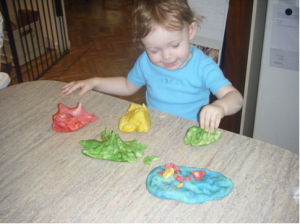
At the end of February I wrote about a great booklet called Early Learners Games And Activities. This booklet not only gives you ideas of activities to do with young children but also “What you can say?” prompts. Julie from Works For Me Homemaking (who now blogs at http://www.theusefulbox.com) left a very insightful comment about “Blanks levels of questioning” and how I could use these to encourage language development in my preschooler.
Julie is a Speech Pathologist by background, so I asked if she would be happy to write further about these levels of questioning for Planning With Kids. So please welcome Julie as my first non family guest writer on the blog! You can find out more about Julie at the end of the post, where you will also find links to excellent articles she has written on childhood speech and language development.
Blanks Levels Of Questioning
It is widely acknowledged that oral language is critical for literacy development and educational success. According to the Department of Education, Science and Training, early childhood teachers (and that includes parents!) “need to attend to children’s oral language development in planning and delivering programs to support early literacy” In many early education settings (and homes), the push toward “outcomes” measurement has meant sacrificing rich oral language experiences (role play, imaginative play, shared reading).
Many parents and educators are unsure how to stimulate children’s oral language development in play and reading. One good method, often used in Speech Pathology, is “levels of questioning”. These “levels of questioning” were developed by Blank, Rose and Berlin (1978). The questions move from concrete to abstract. Understanding the complexity of questions can help in simplifying language or in appropriately challenging language skills. Children need to understand and respond to all these levels of questions to function easily within a year one classroom. Ages given in brackets are averages. Some 2-year olds may cope with level 2-3 questions, while some four year olds may need questions simplified to level 1-2. (Image by M i x y)
Level One (2-3 year olds)
Questions relate to the immediate environment and require concrete thinking. Examples include:
“What is that?”
“What can you see?”
“Find one like this”
“What is — doing?”
“Is it a —?” (yes/no response)
Level Two (3-4 year olds)
Involve some analysis such as classifying/ grouping objects, describing and understanding object functions.
“Find something that can …(cut)”
“What is happening in this picture?”
“Where is the…?” (requires a location response e.g. “under the table” not just pointing
“Find something that is …(red) and …(spiky)”
“How are these different?”
“Which one is … (a fruit)?”
Level Three (4-5 year olds)
Require child to use their own knowledge to make basic predictions, assume the role of another, or make generalizations. Begin to use higher-order thinking skills.
“What will happen next?”
“How do you think he feels?”
“How do I make… (a sandwich)?”
“How are these the same?”
“What is a …?” (definitions)
Level Four (5 years +).
Involve problem solving, predictions, solutions and explanations. Require own knowledge and thinking about the future and past.
Predicting changes: “What will happen if…?”
Solutions: “What should we do now?”
Causes: “How did that happen?”
Justifying: “Why can’t we …eat ice-cream with a knife and fork?”
Explanations: “How can we tell he is sad?”
Example: Play-dough
(a) 2 year old:
Talk a lot about what you and your child are doing FIRST, particularly if you are introducing new vocabulary (e.g. rolling, squashing, cookie-cutter, rolling pin). Ask simple questions such as “What’s this?”, “Is that a star?”, “Find me another heart”, “What am I doing?”
(b) 3 year old:
Questions as above, but add complexity “what colour is the star?”, “what shape did you make?”, “Find something I can use to roll”, “why are those two stars different?”, “What shape is a window?”
(c) 4 year old:
Questions as above and “We flattened the play-dough, what will we do next?”, “What is a rolling pin?”, “You squashed the man! How do you think he feels?”, “What should I do next?”, “How can I make a snail?”
(d) 4+ year old:
Questions above and “what would happen if we mixed all the red and the blue play-dough together”, “Why can’t I play with play-dough on the carpet?”, “Why do you think it is called a ‘cookie-cutter’?”, “I made the table messy. What should I do now?”, “Why do you think the table got so messy?”, “What could I do next time, so I don’t make such a mess?”
How to simplify questions:
(Note: you can do the opposite to extend questions and challenge language)
1) Make questions more concrete.
- Abstract: “How do you think daddy bear felt when baby bear wouldn’t give him a bed-time kiss?”/ Concrete: “Look at daddy bear’s face. What is he doing?”
- Abstract: “Why did you throw all your books on the floor? What should you do now?” / Concrete: “Where are the books? Where do the books go? Let’s put them away.”
2) Relate questions to personal experiences.
- Simplify a question such as “Why do you think firefighters wear such big heavy coats?” to “What does it feel like when you stand close to a fire?”
- “What does mummy say when you don’t finish your jobs? What will your teacher say if you don’t finish your homework?”
3) Ask questions about very recent events or objects that are present.
- Instead of asking “what do you think you will do at playgroup tomorrow?” ask “what did you play with today?” or “what are you playing with now?”
4) Use familiar vocabulary when asking questions.
- Instead of “what is the function of a knife?”, try “what can you do with a knife?”
- Offer a choice. “Is this a violin or a guitar?” instead of “what instrument is this?”
5) For older children, keep using those higher-order thinking questions (level 3 and 4) Instead of telling your child how to solve a problem, ask questions to help them think through it on their own.
____________________________________________________________________________
Julie Miller (B.App. Science (Speech Pathology), M. Ed. (Special Education)) is a Speech Pathologist, wife, mother and recent blogger. She has worked in private practice, community health and early intervention services since graduating in 2000. Julie became a mum to C. in May 2008, and to T. in July 2009 and is currently working 2 hours per fortnight at an early intervention program for children with Autism.
Do you want some free tools to help you organise the chaos of family life?
The Planning With Kids Newsletter is called NOW with Nicole Avery. It is an upbeat weekly newsletter that aims to help you organise the chaos of family life and find simple ways to enjoy it more.
My philosophy is to organise the known and repetitive tasks of family life so you create a solid foundation that allows you to manage the more unpredictable and challenging elements.
You can sign up for the free newsletter in the sign-up box below! To say thank you for signing up for the newsletter I have created a simple but super useful guide for you to help you organise the chaos of family life. The free download helps simplify some of the repetitive and time-consuming tasks that occur as part of daily family life. Guide ✼ Plan ✼ Check ✓ contains 10 separate printable tools that you will be able to use over and over again.

Sign up and organise the chaos of family life!


